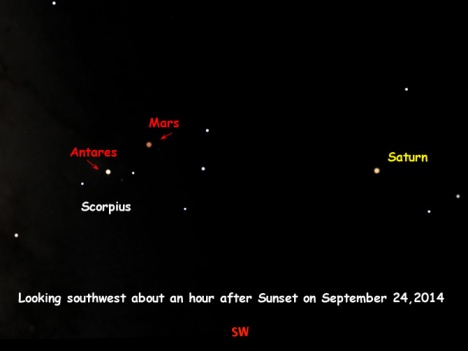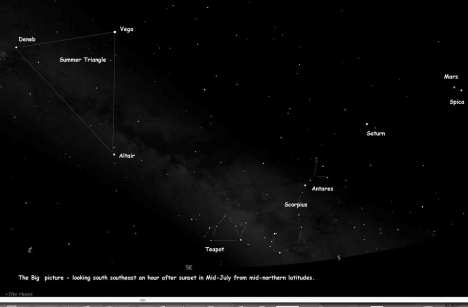Note: This is my first installment of a new feature. It’s a modification of the old “events” post and still is a guide to special events for the month – things happening in the sky that do not repeat from month to month but are special to a particular date. To this I have added – and put emphasis on – information about events that are particularly suitable for capture as photographs – especially photographs that convey a sense of being there and are taken with ordinary cameras. This is in contrast to the traditional astronomy images that use special cameras to show us things we cannot see with the naked eye by taking long exposures and gathering much more light, usually using a telescope as the lens. Greg Stone
September 2014 gives us several special opportunities for nice, naked-eye views of stars and planets that also provide excellent photo opportunities, especially if you have a DSLR camera – or something similar where you can adjust the exposure.
September 8, 2014 – “Super” Moon rising in the Earth’s Shadow/ Belt of Venus
I can’t get real excited about the “Super” Moon idea – we’ve had two this year already, and they’re really not all that unusual, or for that matter not quite as “super” as the word makes them sound.
But the full Moon rising is always a pretty sight and a very easy subject for photographers. One alert, though. The Moon is really quite small – half a degree – and so your picture may show a Moon much smaller than you remember seeing with the naked eye. This is because the full Moon ALWAYS appears to be much larger to us when it’s near the horizon, whether “super” or not. A friend asked me recently why my picture of the Moon conveyed this sense of what he saw, while others didn’t.
The answer is simple. I used a small telephoto lens. Technically it was an 80mm, but because of the sensor on my camera, you have to add a factor of 1.6 to that to get the 35mm – or “full frame” equivalent. So in this case it was like using a 128mm telephoto on a 35mm camera. Lots of simple cameras come with zooms that provide at least that much magnification. Use more magnification and you may end up with a real nice picture – but it may make the Moon look a lot bigger than what people saw with their naked eye.
That brings me to another major point. My whole approach to night sky photography is to try to convey a sense of being there. For that reason I don’t overdo the sensitivity of the CCD – that is, I don’t set the ISO real high – and I do keep the exposures relatively short. With the full Moon in August, I had the ISO set at 1600 – which meant I had a little noise to clean up with the editing software – and I could take the-picture at 1/160th of a second – that’s fast enough to hand hold even with the 128mm telephoto – and the the F-stop was 7.1, small enough to provide some reasonable depth of field.
That last is critical. The Moon is at infinity, but you want to also include some foreground subjects at close and mid-range to give a sense of proportion to the objects in the sky.
Moon rise time varies by your location. Where I am on the eastern seaboard of the US, the Moon will be rising roughly 20 minutes before the Sun sets on September 8th. This is going to provide an interesting opportunity, I think, to catch the Moon in the shadow of the Earth and/or the Belt of Venus. These appear in the east shortly after sunset and after about 15 minutes start melding into the night. The shadow will be a darker blue than the sky above it and extend perhaps a fist above the horizon. The “Belt of Venus” will be a rosy band above the shadow. Bottom line: I think the most interesting shots will be taken about 10-15 minutes after sunset.
Of course, much depends on local weather conditions. For me the trick is to know where the Moon will be rising – just a tad south of east in September 2014 – and find a spot that not only gives me a clear horizon in that direction, but also provides some interesting foreground objects to go along with the Moon.
September 20, 2014 – Algol at minimum brightness
This event – an eclipse of Algol – will be centered on 10:55 pm EDT; on the 17th a similar event will center on 11:06pm PDT. I’m not going to go into detail about the “demon star” here. If you don’t know about it, you can read more in this earlier post.
What I do want to point out is it’s fun to see this star dim, then brighten over the course of a few hours, and if you like taking constellation pictures, it would be neat to get one of Perseus with Algol at full strength and one with Algol at full eclipse.
While these eclipses happen every few days, you’re lucky if you find one or two a month that come at a time convenient for you to watch – and then, of course, the weather has to cooperate.
September 22, 2014 – the Fall Equinox
This is a fun time to get a picture of either sunrise or sunset. You don’t need to be right on this date -a day or two before or after will do fine. The basic idea is to show the Sun in relation to local landmarks and thus identify for yourself the general heading for east or west from any given spot. Actually, a real nice project is to pick a scenic spot, take a picture of a sunrise or sunset as close to the Equinox as you can get, then do the same thing again from the same spot showing the Sun at the Winter and Summer Solstices and at the Spring Equinox. The four will then show the movement of the Sun along the local horizon in the course of a year.
September 24-30 – Mars and its Rival, Plus Saturn
I suggest you go out an hour after sunset and look southwest for three bright “stars” near the horizon. Two should have a reddish hue, one a yellowish hue – though honestly, with them all this close to the horizon the atmosphere may cause them to twinkle and change color.
Still, this is worth seeing and should provide an interesting photographic challenge. However, if you have been taking pictures of constellations, similar settings should work here. (I like to set the ISO at 6400 and expose for four seconds at F7.1 with the camera on a tripod, of course, and using a cable release. This, for me, gives a typical naked eye view – but you need to experiment. I also clean up the background noise in such photographs using Lightroom.)
The main attraction here is that Mars – the red planet – is near Antares, a red star. In fact, the name “Antares” means “rival of Mars” because its color rivals the obviously ruddy planet. Saturn is farther away but has a distinctly yellowish hue. In the course of these six evenings, Mars will first draw a bit closer to Antares, then get farther away. Saturn will also get lower each night, though Mars is moving in a counter direction right now and will appear to hold its altitude – that is, be at the same height at the same time. Of course, all of these will get too close to the horizon and eventually set, so timing is important. I plan to start an hour after sunset, then see what works best over the next half hour or so as the sky gets darker, but Antares, Mars, and Saturn also get lower.
Again, the challenge for me is to include foreground objects and show the night sky as we really experience it. Here’s a shot, for example, that I took last winter of Orion – with a quite bright Moon out of the picture to the left.
Crescent Moon and Planets in September 2014
I see two photo opportunities to capture a crescent Moon near major planets. On September 20, 2o14, the Moon should be within about 6 degrees of Jupiter, both about one-third the way up the eastern sky an hour before dawn. As Jupiter fades, Venus may put in an appearance near the horizon, though it’s getting quite close to the Sun.
On September 27, 2014, Saturn will have an even closer encounter with the Moon in the southwestern sky at dusk. Yep – this is in the middle of the period suggested to capture Antares, Mars, and Saturn – so if the weather gives you a break you might get a crescent Moon as a bonus.
Filed under: 2. Astro Events, i. September | Tagged: Algol, Antares, crescent Moon, Demon Star, Jupiter, mats, night sky photography, Saturn, super moon | 1 Comment »

























